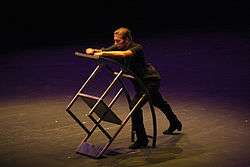Israel Galván
Israel Galván Reyes (born 1973 in Seville) is a Spanish flamenco dancer (bailaor) and choreographer. He grew up learning and dancing with his father, the dancer José Galván, and his mother, Eugenia Reyes.

Israel Galván
He became a celebrity in flamenco thanks to his dancing steps with complicated feet movements, showing rapid-fire footwork punctuated by moments of stillness and silence. His art is a kind of avantgarde flamenco. He has been awarded several dance prizes.
Career
- In 1994 he joined the Compañia Andaluza de Danza directed by Mario Maya, and over the next decade won just about every top flamenco prize possible, including the Giradillo prize at Seville's flamenco Biennal, the Flamenco Hoy critics’ award for best dancer of the year, which he received in both 2001 and 2005. In the same year he also won Spain's national dance prize for the creative renewal of the Flamenco[1] and in 2008 Premio Ciutat de Barcelona.
- After forming his own company in 1998 to create his first work Mira Los Zapatos Rojos, his reputation as a risk taker increased with each new work. Metamorphosis, his flamenco version of Kafka’s novelette; Arena, his dramatic and surprising choreography based on bull fighting; La Edad de Oro, in which he clings to references tracking the normal approaches and shuns "Age"; Tabula Rasa in which he turns the canon upside down to offer his conceptualist and baroque vision of flamenco; Solo, his most experimental and risky piece in which silence plays as music. And his personal and so impacting vision of «the Apocalypse», El Final de este estado de cosas redux, premiered at the Operahouse La Maestranza in Seville (Summer 2008).
- In each of his works, Israel Galván has collaborated with classic flamenco artists including Fernando Terremoto, Inés Bacan, Bobote, El Electrico, and contemporary flamenco innovators including Enrique Morente, Gerardo Núñez, Miguel Poveda, Diego Carrasco, Diego Amador, Alfredo Lagos, and other contemporary musicians.
- His work 'Lo Real/ Le Réel/ The Real' in 2013 was controversial: The standing ovation from the crowd that packed the Stasschouwburg in Amsterdam, was in marked contrast to the more conservative and hostile reaction to the premiere in Madrid. This was attributable to its treatment of a sensitive and emotive subject, the Nazi Holocaust against the gypsies. In addition, Galván's performance was controversial, his body expressing the role in a sort of body art or actionism of the body with certain self-inflicted violence. He changed his physique for this show, continuing that Kafkaesque process he undertook some years before with 'La metamorfosis'. And he's a victim of extermination. One who fights, who rebels, who swells with pride, who expresses his grief, who swears vengeance... but a victim who falls prey to death.
- In Madrid, on 27 June 2014, the world premiere of the genre-bordering work "Torobaka" (a word play from the Spanish words "toro" (bull) and "vaca" (cow as an allusion to the sacred cow in Indian culture) took place. Israel Galván appeared there together with Akram Khan, English choreographer and dancer with Bengali roots. Both were accompanied by polyphonic music with elements of Gregorian chorales, liturgical chants, Hindu songs, and the sounds of Anda Jaleo.[2][3]
- Also in 2014, Israel Galván published his work "FLA.CO.MEN". On his website it is said to be a concert.[4] In this piece, Galván deconstructs the flamenco and reunites it humorously. The music is partly free jazzy to experimental, but also traditional.[5]
- Premios Max is the most important theatre award in Spain. In 2014, Israel Galván won the award in the 3 categories Coreografía, Interpretación and Espectáculo for his work 'Lo Real'.[6] In 2015 he won the award in the category Bailarín Principal in his work FLA.CO.MEN. Rocío Molina and Olga Pericet also won the award.[7]
- On the 6th of May 2017 Israel Galván performed the world premiere of "La Fiesta" in the Austrian city St. Pölten.[8] This work describes the hour after the actual flamenco performance, when the bailaoras and bailaores improvise with their musicians in something akin to a jam session.[9]
Awards
- 2016: Critics' Circle National Dance Award : Special award for exceptional artistry
gollark: You can't just magically add extra hardware to things and somehow influence AI behavior.
gollark: Those do not, in fact, actually exist.
gollark: ························ no you utter triskaidecagonal idiot.
gollark: Anyway, checksumming potatOS files on bootup would be good, except potatOS doesn't really have versions as such and there's no build process which could generate a hash.
gollark: This is not just some fun thing you can trifle with. Unfriendly AI threatens literally all humanity.
External links
References
- "Israel Galván". A Negro Producciones. Retrieved 2017-03-19.
- anda! Zeitschrift für Flamenco, Nr. 115, August/September 2014, S 20 - 21, Israel Galván, Akram Khan – Torobaka (German print magazine for flamenco)
- https://www.theguardian.com/stage/2014/nov/04/torobaka-akram-khan-israel-galvan-sadlers-wells-review
- http://www.anegro.net/index.php/israel-galvan/fla-co-men
- https://www.theguardian.com/stage/2017/feb/17/israel-galvan-flacomen-review-sadlers-wells-london-flamenco-reinventions-show
- http://www.premiosmax.com/dyn/prensa/prensa/ficha.php?id_seccion=55&id_nota=229y
- http://www.globalflamenco.com/2015/05/19/los-premios-max-2015-galardonan-el-flamenco-contemporaneo-de-israel-galvan-rocio-molina-y-olga-pericet/
- https://www.festspielhaus.at/en/residencies/artists-in-residence/israel-galvan/world-premiere-at-the-festspielhaus
- http://minakoseki.com/work/israel-galvan-la-fiesta/
This article is issued from Wikipedia. The text is licensed under Creative Commons - Attribution - Sharealike. Additional terms may apply for the media files.